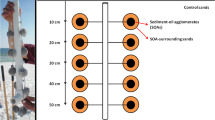A field study was initiated in February 1996 in a remote sandy beach of The Grande Terre (Kerguelen Archipelago, 69° 42° E, 49° 19° S) with the objective of determining the long-term effects of some bioremediation agents on the biodegradation rate and the toxicity of oil residues under severe subantarctic conditions. A series of 10 experimental plots were settled firmly into sediment. Each plot received 2L of Arabian light crude oil and some of them were treated with bioremediation agents: slow release fertilizer Inipol EAP-22 (Elf Atochem) or fish composts. Plots were sampled on a regular basis over a 3-year period. A two-order of magnitude increase of saprophytic and hydrocarbon-utilizing microorganisms occurred during the first month of the experiment in all treated enclosures, but no clear differences appeared between the plots. Very high microbial populations were present during the experiment. Biodegradation within treated spots was faster than within the untreated ones and appeared almost complete after 6 months as indicated by the degradation index of aliphatic hydrocarbons within all plots. The analysis of interstitial water collected below the oily residues presented no toxicity. However, a high toxicity signal, using Microtox solid phase, appeared for all oiled sand samples with a noticeable reduction with time even if the toxicity signal remained present and strong after 311 days of oil exposition. As a conclusion, it is clear that the microbial response was rapid and efficient in spite of the severe weather conditions, and the rate of degradation was improved in presence of bioremediation agents. However, the remaining residues had a relatively high toxicity.
Similar content being viewed by others
Author information
Authors and Affiliations
Rights and permissions
About this article
Cite this article
Delille, D., Delille, B. & Pelletier, E. Effectiveness of Bioremediation of Crude Oil Contaminated Subantarctic Intertidal Sediment: The Microbial Response . Microb Ecol 44, 118–126 (2002). https://doi.org/10.1007/s00248-001-1047-z
Received:
Accepted:
Issue Date:
DOI: https://doi.org/10.1007/s00248-001-1047-z




